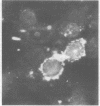Abstract
A quantitative radioassay was used to study the adherence of group A Streptococcus to Madin-Darby canine kidney cells infected with influenza A virus (strains FM1, Jap 305, and NWS) and reacted with fibrinogen. Treatment of virus-infected cell cultures with human fibrinogen significantly enhanced streptococcal adherence (P less than 0.0005) compared with adherence to untreated, virus-infected cells and uninfected control cells. Enhanced adherence was not seen with NWS virus-infected cell cultures or with virus-infected cells treated with human fibronectin, canine fibrinogen, or porcine fibrinogen. Human fibrinogen was shown to bind directly to surface membranes of virus-infected cells. Virus-infected cell cultures were incubated in the presence of tunicamycin, an antibiotic that inhibits glycosylation of virus-specific surface membrane glycoproteins. We found that with increasing antibiotic concentration there was a progressive decrease in fibrinogen-mediated streptococcal adherence. Adherence of 3H-labeled streptococci to fibrinogen-treated, virus-infected cell cultures showed saturation kinetics and could be blocked with monospecific antibodies against fibrinogen. These results suggest that human fibrinogen binds to a glycoprotein moiety on the surface of influenza A virus-infected cells, and that once bound the fibrinogen molecule acts as an "acquired" receptor for the attachment of group A Streptococcus. We postulate that this mechanism, it if occurs in vivo, might help explain the observed association between influenza A virus infection and subsequent bacterial superinfection with group A Streptococcus.
Full text
PDF







Images in this article
Selected References
These references are in PubMed. This may not be the complete list of references from this article.
- Austin R. M., Daniels C. A. The role of protein A in the attachment of staphylococci to influenza-infected cells. Lab Invest. 1978 Aug;39(2):128–132. [PubMed] [Google Scholar]
- Beachey E. H. Bacterial adherence: adhesin-receptor interactions mediating the attachment of bacteria to mucosal surface. J Infect Dis. 1981 Mar;143(3):325–345. doi: 10.1093/infdis/143.3.325. [DOI] [PubMed] [Google Scholar]
- Colvin R. B., Gardner P. I., Roblin R. O., Verderber E. L., Lanigan J. M., Mosesson M. W. Cell surface fibrinogen-fibrin receptors on cultured human fibroblasts. Association with fibronectin (cold insoluble globulin, LETS protein) and loss in SV40 transformed cells. Lab Invest. 1979 Nov;41(5):464–473. [PubMed] [Google Scholar]
- Davison V. E., Sanford B. A. Adherence of staphylococcus aureus to influenza A virus-infected Madin-Darby canine kidney cell cultures. Infect Immun. 1981 Apr;32(1):118–126. doi: 10.1128/iai.32.1.118-126.1981. [DOI] [PMC free article] [PubMed] [Google Scholar]
- Davison V. E., Sanford B. A. Factors influencing adherence of Staphylococcus aureus to influenza A virus-infected cell cultures. Infect Immun. 1982 Sep;37(3):946–955. doi: 10.1128/iai.37.3.946-955.1982. [DOI] [PMC free article] [PubMed] [Google Scholar]
- Elbein A. D., Gafford J., Kang M. S. Inhibition of lipid-linked saccharide synthesis: comparison of tunicamycin, streptovirudin, and antibiotic 24010. Arch Biochem Biophys. 1979 Sep;196(2):311–318. doi: 10.1016/0003-9861(79)90583-6. [DOI] [PubMed] [Google Scholar]
- Elbein A. D., Sanford B. A., Ramsay M. A., Pan Y. T. Effect of inhibitors on glycoprotein biosynthesis and bacterial adhesion. Ciba Found Symp. 1981;80:270–287. doi: 10.1002/9780470720639.ch17. [DOI] [PubMed] [Google Scholar]
- Grinnell F., Feld M., Minter D. Fibroblast adhesion to fibrinogen and fibrin substrata: requirement for cold-insoluble globulin (plasma fibronectin). Cell. 1980 Feb;19(2):517–525. doi: 10.1016/0092-8674(80)90526-7. [DOI] [PubMed] [Google Scholar]
- Hryniewicz W., Lipinski B., Jeljaszewicz J. Nature of the interaction between M protein of Streptococcus pyogenes and fibrinogen. J Infect Dis. 1972 Jun;125(6):626–630. doi: 10.1093/infdis/125.6.626. [DOI] [PubMed] [Google Scholar]
- KANTOR F. S. FIBRINOGEN PRECIPITATION BY STREPTOCOCCAL M PROTEIN. I. IDENTITY OF THE REACTANTS, AND STOICHIOMETRY OF THE REACTION. J Exp Med. 1965 May 1;121:849–859. doi: 10.1084/jem.121.5.849. [DOI] [PMC free article] [PubMed] [Google Scholar]
- Kronvall G., Schönbeck C., Myhre E. Fibrinogen binding structures in beta-hemolytic streptococci group A, C, and G. Comparisons with receptors for IgG and aggregated beta 2-microglobulin. Acta Pathol Microbiol Scand B. 1979 Oct;87(5):303–310. [PubMed] [Google Scholar]
- Kronvall G., Simmons A., Myhre E. B., Jonsson S. Specific absorption of human serum albumin, immunoglobulin A, and immunoglobulin G with selected strains of group A and G streptococci. Infect Immun. 1979 Jul;25(1):1–10. doi: 10.1128/iai.25.1.1-10.1979. [DOI] [PMC free article] [PubMed] [Google Scholar]
- Laemmli U. K. Cleavage of structural proteins during the assembly of the head of bacteriophage T4. Nature. 1970 Aug 15;227(5259):680–685. doi: 10.1038/227680a0. [DOI] [PubMed] [Google Scholar]
- Loosli C. G. Influenza and the interaction of viruses and bacteria in respiratory infections. Medicine (Baltimore) 1973 Sep;52(5):369–384. doi: 10.1097/00005792-197309000-00001. [DOI] [PubMed] [Google Scholar]
- McConahey P. J., Dixon F. J. A method of trace iodination of proteins for immunologic studies. Int Arch Allergy Appl Immunol. 1966;29(2):185–189. doi: 10.1159/000229699. [DOI] [PubMed] [Google Scholar]
- Pan Y. T., Schmitt J. W., Sanford B. A., Elbein A. D. Adherence of bacteria to mammalian cells: inhibition by tunicamycin and streptovirudin. J Bacteriol. 1979 Aug;139(2):507–514. doi: 10.1128/jb.139.2.507-514.1979. [DOI] [PMC free article] [PubMed] [Google Scholar]
- Piazzi S. E. A simple method for preliminary immunodiffusion test of antigen-antibody systems having unknown ratios of reaction. Anal Biochem. 1969 Feb;27(2):281–284. doi: 10.1016/0003-2697(69)90033-5. [DOI] [PubMed] [Google Scholar]
- Sanford B. A., Shelokov A., Ramsay M. A. Bacterial adherence to virus-infected cells: a cell culture model of bacterial superinfection. J Infect Dis. 1978 Feb;137(2):176–181. doi: 10.1093/infdis/137.2.176. [DOI] [PubMed] [Google Scholar]
- Sanford B. A., Smith N., Shelokov A., Ramsay M. A. Adherence of group B streptococci and human erythrocytes to influenza A virus-infected MDCK cells. Proc Soc Exp Biol Med. 1979 Feb;160(2):226–232. doi: 10.3181/00379727-160-40424. [DOI] [PubMed] [Google Scholar]
- Schwarz R. T., Rohrschneider J. M., Schmidt M. F. Suppression of glycoprotein formation of Semliki Forest, influenza, and avian sarcoma virus by tunicamycin. J Virol. 1976 Sep;19(3):782–791. doi: 10.1128/jvi.19.3.782-791.1976. [DOI] [PMC free article] [PubMed] [Google Scholar]
- Waechter C. J., Harford J. B. Evidence for the enzymatic transfer of N-acetylglucosamine from UDP--N-acetylglucosamine into dolichol derivative and glycoproteins by calf brain membranes. Arch Biochem Biophys. 1977 May;181(1):185–198. doi: 10.1016/0003-9861(77)90497-0. [DOI] [PubMed] [Google Scholar]



